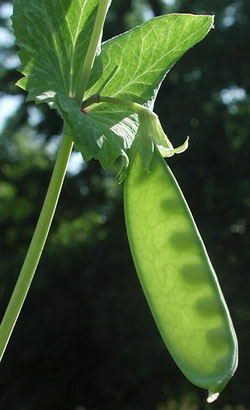Peas, English & Edible Pod
Peas (Pisum sativum) are a cool-season vegetable that must be planted in early spring to ensure good yields in Kentucky. Types include the English pea (shelled for the fresh green seeds within non-edible pods), sugar snap types (round, fleshy edible pods), and Asian pod types (thin, flat edible pods; also called snow peas).
Marketing
 Farm fresh pea sales at farmers markets account for most of Kentucky’s commercial acreage. Other fresh market options include community supported agriculture (CSA) subscriptions, produce auctions, U-pick, and roadside stands. Sales to locally owned retail grocery markets may be an option for edible pod peas. English peas are a minor part of Kentucky’s commercial vegetable production. Though popular with many consumers, peas involve intensive harvest labor and will demand mechanical harvest for profitable larger-scale production. For most Kentucky growers, peas will be used best as an early season crop to add flavor and variety to the direct market crop mix. Sugar snap peas prove especially popular at some direct market venues. Fresh edible pod peas, on the other hand, are frequently used in Asian and other ethnic dishes and are a popular farmers market item. Their popularity may be attributed to more consumer interest in different types of healthy cuisines and more interest in ethnic foods. Edible pod peas are also more convenient to prepare for eating, and convenience is valued by many consumers.
Farm fresh pea sales at farmers markets account for most of Kentucky’s commercial acreage. Other fresh market options include community supported agriculture (CSA) subscriptions, produce auctions, U-pick, and roadside stands. Sales to locally owned retail grocery markets may be an option for edible pod peas. English peas are a minor part of Kentucky’s commercial vegetable production. Though popular with many consumers, peas involve intensive harvest labor and will demand mechanical harvest for profitable larger-scale production. For most Kentucky growers, peas will be used best as an early season crop to add flavor and variety to the direct market crop mix. Sugar snap peas prove especially popular at some direct market venues. Fresh edible pod peas, on the other hand, are frequently used in Asian and other ethnic dishes and are a popular farmers market item. Their popularity may be attributed to more consumer interest in different types of healthy cuisines and more interest in ethnic foods. Edible pod peas are also more convenient to prepare for eating, and convenience is valued by many consumers.
Production
 Most pea varieties that are used for commercial wholesale production are mechanically harvested, are self-supporting, and tend to have a determinate habit with large bunches of pea pods near the tops of plants. Varieties can have heavy foliage with lots of leaflets or they can be virtually leafless, with most leaflets forming tendrils instead. Leafless types are preferred for wholesale production due to the ease of harvest. Indeterminate types are often used for smaller plantings. These cultivars can be planted in either double or single rows; plants in double rows will support each other. However, tall growing indeterminate varieties over 3 feet high will require the construction of plant supports. Trellising helps keep pods from touching the ground and promotes better air circulation, resulting in increased yields and quality. Trellising adds to labor and input costs.
Most pea varieties that are used for commercial wholesale production are mechanically harvested, are self-supporting, and tend to have a determinate habit with large bunches of pea pods near the tops of plants. Varieties can have heavy foliage with lots of leaflets or they can be virtually leafless, with most leaflets forming tendrils instead. Leafless types are preferred for wholesale production due to the ease of harvest. Indeterminate types are often used for smaller plantings. These cultivars can be planted in either double or single rows; plants in double rows will support each other. However, tall growing indeterminate varieties over 3 feet high will require the construction of plant supports. Trellising helps keep pods from touching the ground and promotes better air circulation, resulting in increased yields and quality. Trellising adds to labor and input costs.

